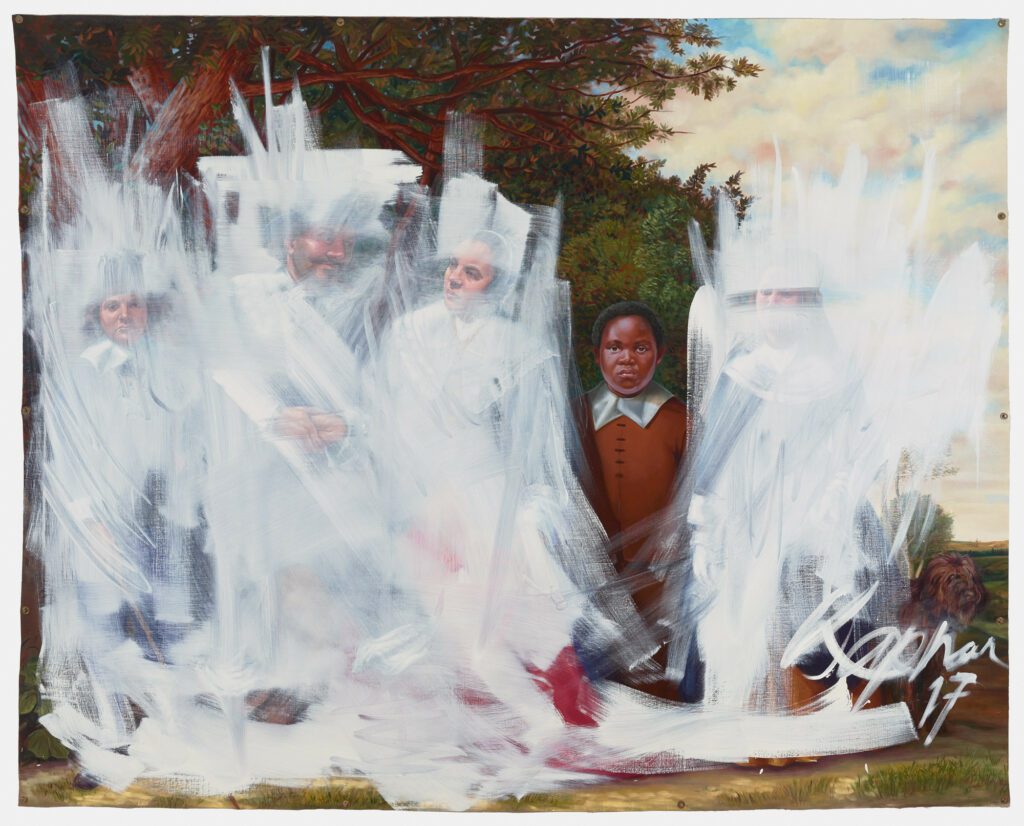Brooklyn Museum , New York, United States
21 Jun 2019 - 13 Oct 2019

Titus Kaphar (American, born 1976). Shifting the Gaze, 2017. Oil on canvas, 83 × 1031/4 in. (210.8 × 262.3 cm). Brooklyn Museum, William K. Jacobs Jr., Fund, 2017.34. © Titus Kaphar. (Photo: Courtesy of Jack Shainman Gallery)
Titus Kaphar is a contemporary American painter whose work recasts and reimagines the individuals who have often been marginalized or left out of traditional Western art.
As the focus of the exhibition One: Titus Kaphar, the Brooklyn Museum presents the artist’s monumental painting, Shifting the Gaze (2017), a work based on a seventeenth-century Dutch portrait of a prosperous white European family, which Kaphar strategically painted over during a 2017 TED Talk, leaving visible a Black boy believed to be the family’s servant. With his conscious refocusing of the viewer’s gaze to the boy, Kaphar draws attention to groups who have been excluded from art-historical narratives and points to the need to amend these histories so they are more honest and inclusive. The exhibition is part of the Brooklyn Museum’s continuing effort to present exhibitions that take a critical look at the art- historical canon, questioning the Eurocentric viewpoint from which art history has traditionally been explored and centering new perspectives. The exhibition is curated by Eugenie Tsai, John and Barbara Vogelstein Senior Curator of Contemporary Art, Brooklyn Museum. It is part of the One Brooklyn series, in which each exhibition focuses on an individual work from the Brooklyn Museum’s encyclopedic collection, revealing the many stories woven into a single work of art.
Titus Kaphar (b. 1976) is best known for his body of work that responds to pressing social issues at the intersection of racial justice, activism, and representation. Kaphar’s paintings often borrow from classical Western art and seek to forefront suppressed histories and connect them to contemporary concerns. The work on view in One: Titus Kaphar was completed on stage as a dramatic conclusion to his TED Talk in April 2017, “Can Art Amend History?,” which explored how the encoded language of art conveys the power and privilege of its subjects. He presented to the audience his own painting, based on the seventeenth- century Dutch painting Family Group in a Landscape (circa 1645–1648), by Frans Hals, which depicts a European couple, their two children, and an African servant, all posed against a landscape. After asking the audience what they see in the painting, Kaphar describes the power relations inherent in the image—from the compositional hierarchy that puts the white figures in the foreground to the detailed depiction of the silk and lace dresses the wife and daughter are wearing. During the talk, Kaphar uses white pigment mixed with linseed oil to veil the figures of the couple and children with broad brushstrokes—shifting the audience’s attention to the figure of the Black boy. Framed by a wide collar and Kaphar’s whitewashed brushstrokes, the boy’s face is suddenly illuminated, no longer blending into the landscape behind him.
Kaphar notes that he doesn’t seek to permanently erase the other figures; the linseed oil mixed into the paint will allow the faces and bodies of the family members to reemerge over time. “We can’t erase this history, it’s real. We have to know it,” he explains. Instead, he momentarily refocuses our gaze on what we haven’t seen in the past, thereby encouraging a more truthful understanding of the present. Kaphar’s 2017 TED Talk will be on view as part of the presentation.
One: Titus Kaphar will be presented in conjunction with Rembrandt to Picasso: Five Centuries of European Works on Paper, an exhibition of more than 120 works on paper from the Brooklyn Museum’s collection, featuring such masters as Albrecht Dürer, Paul Gauguin, Francisco Goya, Vincent van Gogh, Berthe Morisot, Pablo Picasso, and Rembrandt van Rijn. Commentary by Kaphar, which is drawn from conversations he had with the curators of both exhibitions, will accompany a select number of prints and drawings in Rembrandt to Picasso, shining a light on the often incomplete historical narrative presented by the predominantly white, male artists of the traditional Western canon. Kaphar’s words help shift our gaze, posing questions about familiar works and providing a context for viewing them in new, unexpected ways.
“Titus Kaphar’s work encourages us to think about who has been empowered to write the dominant narratives throughout history. It also pushes us to think about who has traditionally been excluded from these histories,” said Eugenie Tsai. “Shifting the Gaze is a welcome addition to the Museum’s collection, as it reminds us to widen the lens we use to look at art- historical masterworks already in the collection.”
One Brooklyn is made possible by a generous contribution from JPMorgan Chase & Co.
.